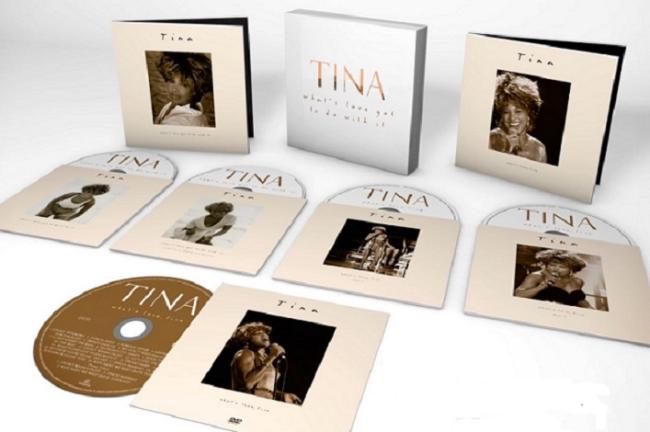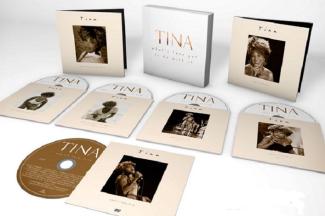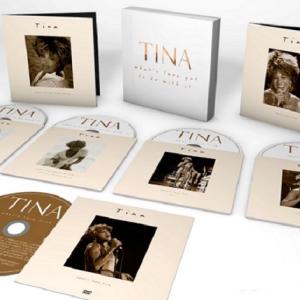Turner’s ‘Private Dancer’ expanded, Nicky Hopkins remembered
Tina Turner: Private Dancer 40th Anniversary edition (Parlophone/Rhino, 5 CDs + Blu-ray). Following the same format as 2003’s expanded celebration of Turner in the “What’s Love Got to Do with It” box set, “Private Dancer” has been remastered and expanded with B-sides, non-album singles and, this time, two live shows, one of which also is presented visually on the Blu-ray and just happens to have Bryan Adams and David Bowie as guests.
The album itself (44:02) is a classic in Turner’s discography, with the hits “What’s Love Got to Do with It” (a U.S. chart topper), “I Can’t Stand the Rain” (a big hit in Germany; originally done by Ann Peebles), Mark Knopfler’s “Private Dancer” (with a Jeff Beck guitar solo), “Let’s Stay Together” (U.K. top 10) and “Show Some Respect” (U.S. top 40). Additionally, it has covers of The Beatles’ “Help” and Bowie’s “1984” (with a male chorus), plus the Holly Knight-Mike Chapman-Nicky Chinn-written “Better Be Good to Me.” The weakest track is the pell-mell rocker “Steel Claw” (also featuring Beck), one of only two songs from the album she does not perform in the Birmingham, England show, the other being “1984,” but then she had Bowie onstage to sing “Tonight” and two different “Let’s Dance” numbers with her.
Overall, the album was Turner’s fifth solo album, but came after several challenging years that followed her divorce from Ike Turner. (I first saw Tina as part of the Ike and Tina Turner Revue that played Northwestern University in the late 1960s, along with Smokey Robinson and the Miracles.) A worldwide success, the album made Turner a viable solo star, one capable of filling arenas, as well as one of the most marketable crossover singers. The album earned multi-platinum certifications and remains her best-selling album in North America to date. In 2020, the album was selected by the Library of Congress for preservation in the National Recording Registry.
The second CD contains five B-sides, four single edits and four extended versions. The B-sides include the decent rocker “I Wrote a Letter,” the Tom Snow ballad “Rock ‘n’ Roll Widow,” a nice cover of The Animals’ “When I Was Young” and the good rocker “Keep Your Hands Off My Baby.” The single edits are of “Let’s Stay Together,” “Help,” “Better Be Good to Me” and “Private Dancer.” Of more interest are the extended versions, especially “Better Be Good to Me” and “I Can’t Stand the Rain.”
The heightened interest continues on the third CD, which includes four previously-unreleased tracks, including an alternative radio mix and an instrumental version of “Let’s Stay Together.” “Hot for You Baby” is a rocker with a male chorus, recently discovered in the archives and released to radio. The fourth unearthed track is a fine dub version of “What’s Love Got to Do with It.”
Next on CD is the real treats, seven non-album singles, starting with a cover of the Temptations’ hit, “Ball of Confusion (That’s What the World Is Today).” Produced by Martyn Ware of Heaven 17, “Ball of Confusion” very much has the same sound as Heaven 17’s “Penthouse and Pavement” album (1981, a personal favorite). Ware, along with Greg Walsh, also produced the main album’s cover of Al Green’s “Let’s Stay Together” and Bowie’s “1984.”
Her hit single “We Don’t Need Another Hero (Thunderdome),” from the film “Mad Max: Thunderdome,” which Turner also starred in, is next and also is presented in an even better extended version, plus an instrumental version. Then there are three versions of Holly Knight’s “One of the Living,” which has a nice stomp beat. The other two versions are a special club mix and a dub version.
The two live shows on discs four and five show the evolution of Turner’s stage show, with the Aug. 2, 1984 show at Chicago’s Park West still including four old favorites – “River Deep Mountain High,” “Nutbush City Limits” and concluding with “Proud Mary” and ZZ Top’s “Legs” (stretching to 10:25 as Turner works the crowd) – but also having seven songs from the “Private Dancer” album. The show is terrific.
The fifth CD and the Blu-ray have the Brimingham show (54:22), featuring her fine band of pianist Kenny Moore, who joins in singing “I Can’t Stand the Rain”; hulky Timmy Cappello on keyboards and often-highlighted saxophone; Jack Bruno on drums; James Ralston on guitar and vocals; and Bob Feit on bass and vocals. Jamie West-Oram of The Fixx is a guest guitarist. Turner performs eight of the new album’s 10 songs in her 12-song set.
All the album songs come off very well, with the six more familiar numbers among the highlights. Then come the guest treats with a terrific “It’s Only Love,” a rocker featuring co-author Bryan Adams on vocals and guitar. The pair would issue a single version later on. Smooth-as-ever David Bowie joins Turner for “Tonight,” which he wrote with Iggy Pop, and two “Let’s Dance,” the first written by Jim Lee and the second by Bowie. “Tonight” is done reggae style and Turner and Bowie slow dance during the song’s instrumental break.
The Blu-ray also includes eight promotional videos (32:18), covering six songs as there are two different-length versions of both “Private Dancer” and “What’s Love Got to Do with It.” Most of the videos do not move the needle much, except for the two that feature her band, namely “Better Be Good to Me” and “Show Some Respect.” “What’s Love Got to Do with It” has her wandering New York City streets in the color version and a night club in the black-and-white version, while “Private Dancer” has her enter a dance club and the second version is simply edited down.
The 32-page booklet includes a lengthy essay by Jason Draper, vintage photos and photos of single sleeves. The album earned Turner four Grammy Awards: Best Female Rock Vocal Performance for “Better Be Good to Me”; and Best Female Pop Vocal Performance, Record of the Year and Song of the Year for “What’s Love Got to Do with It.” Grade: set A+
The Session Man: Nicky Hopkins (The Session Man Ltd., DVD, NR, 86 min.). The documentary tells the story of Nicky Hopkins, the prolific virtuoso session pianist who contributed to more than 250 albums, including on solo albums by all four Beatles and 14 Rolling Stones albums. Classically trained, his legendary piano riffs and musical motifs helped ordinary tracks become iconic. By late 1960s, Hopkins was one of the busiest and most successful session players, regularly commuting across the Atlantic Ocean to play in London and Los Angeles.
Among those who recorded with Hopkins and discuss his work here are Keith Richards and Mick Jagger of the Stones, Dave Davies of The Kinks, Pete Townshend of The Who, Peter Frampton, Graham Parker, P.P. Arnold, Terry Reid, Nils Lofgren, Chuck Leavell (who plays piano demonstrations), and Jorma Kaukonen and Jack Casady of Jefferson Airplane. His widow Moira Hopkins is interviewed. There are interview segments from 1991 with Hopkins himself.
Hopkins, who suffered from Crohn’s Disease throughout his life, died in 1994 at age 50.
An Englishman, Hopkins, who also played harpsichord, joined his first band at 16. It included Albert Lee. Among the many albums he played on were “Who’s Next,” “The Who by Numbers,” Cat Stevens’ “Matthew and Son,” the Jeff Beck Group’s “The Truth Album” (which got him to America for the first time), Jefferson Airplane’s “Volunteers,” five albums by Quicksilver Messenger Service, John Lennon’s “Imagine,” Harry Nilsson’s “Son of Schmilsson.” Classic songs he played on include “Sympathy for the Devil” by the Rolling Stones, “Jealous Guy” by John Lennon, “You Are So Beautiful” by Joe Cocker and “Photograph” by Ringo Starr, just to mention a few.
Moira Hopkins says Nicky believed he was a reincarnation of pianist Frédéric François Chopin. Certainly, he was extremely talented and this film helps shed light on his contributions to some of the most well-known songs in rock history. Grade: A
McCartney: Now and Then (United Kingdom, R2R/Darkside Releasing, Blu-ray, NR, 52 min.). Paul McCartney himself is interviewed quite a bit in this documentary on his work both with The Beatles and afterwards. In fact, it begins with his induction into the Rock and Roll Hall of Fame. The main purpose of the documentary by Robin Bextor seems to be that, contrary to popular opinion, McCartney was more the Beatles’ rebel than John Lennon was, starting with the fact that Lennon’s family had some money, while McCartney’s was poor.
When McCartney stayed with the Asher family in London, he was introduced to the art scene before Lennon was, the documentary says, adding that McCartney had an exploratory nature and was the band’s innovator. It points out McCartney was the driving force behind the “Magical Mystery Tour” film project.
Given the film’s brief time, it probably will leave most fans wanting more, but it does well on the subjects it touches on, such as The Beatles’ development as performers during their early stay in Hamburg, Germany, when Paul Best, who is interviewed, was their first drummer and they would play for eight hours at a time, giving them a large war chest of songs and making two-hours shows back home in Liverpool seem easy.
Among McCartney’s interesting admissions is that he liked the group dressing alike once under Brian Epstein’s management; that the group felt Ringo Starr was the best drummer in Liverpool; that the group was very nervous prior to performing on the “Ed Sullivan Show”; and that “John’s (Lennon) still my greatest hero.”
Among the others interviewed are Allan Williams, The Beatles’ first manager; Klaus Voorman, the German musician who worked with the band members on their solo albums and designed the “Revolver” album cover; record producer George Martin; singer-songwriter Donovan, who accompanied The Beatles on their famed trip to India; and musicians Roger McGuinn of The Byrds, Brian Wilson of The Beach Boys and Paul Kantner of Jefferson Airplane. Grade A-
About this blog:

My music review column, Playback, first ran in February 1972 in The Herald newspapers of Paddock Publications in Arlington Heights, IL. It moved to The Camden Herald in 1977 and to The Courier Gazette in 1978, where it was joined by my home video reviews in 1993. The columns ran on VillageSoup for awhile, but now have this new home. I worked at the Courier Gazette for 29 years, half that time as Sports Editor. Recently, I was a selectman in Owls Head for nine years.


























